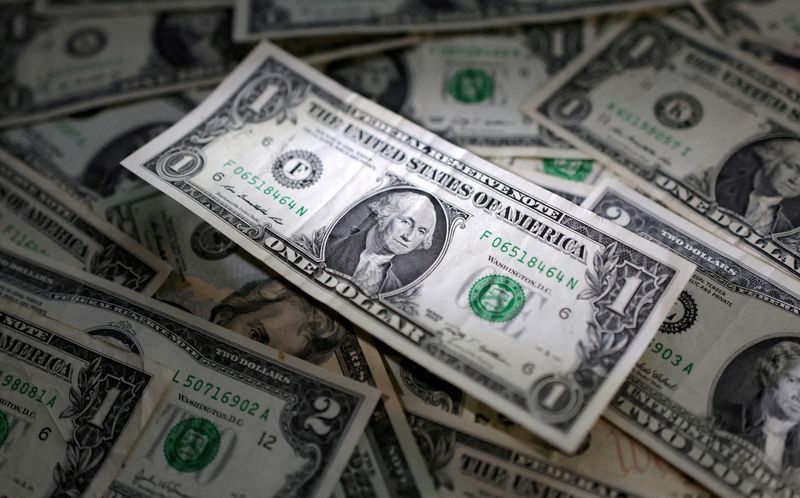Forex
Dollar eases as risk appetite improves on China’s measures


© Reuters. FILE PHOTO: U.S. dollar banknotes are seen in this illustration taken March 10, 2023. REUTERS/Dado Ruvic/Illustration/File Photo/
By Joice Alves
LONDON (Reuters) – The safe-haven dollar fell on Monday as risk sentiment improved on hopes China’s policy stimulus might stabilise the economy, while U.S. jobs data boosted bets the Federal Reserve could be at the end of its rate hike cycle.
With U.S. markets closed on Monday, liquidity is likely to be thin and traders hesitant to place large bets.
The dollar, against a basket of currencies, inched 0.15% lower to 104.08, but remained close to the two-month peak of 104.44 it touched on Aug. 25. The index gained 1.7% in August, snapping a two-month losing streak.
China stepped up measures to boost the country’s faltering economy, with Beijing planning further action including relaxing home-purchase restrictions.
The China-sensitive euro was up 0.25% at $1.0799, just off a 10-week low touched last week against the dollar. The single currency has weakened almost 12% this summer.
The Australian dollar and the New Zealand dollar also got a lift from those measures. [AUD/]
“The U.S. dollar is softening against most other G10 currencies today as risk appetite improves on the back of China support measures,” said Jane Foley, head of FX strategy at Rabobank.
In the meantime, data on Friday showed U.S. job growth picked up in August, but the unemployment rate jumped to 3.8%, while wage gains moderated.
A string of economic data highlighting moderating inflation as well as an easing labour market have added to the impression the U.S. economy is cooling without slowing sharply, reinforcing hopes that the economy is set for a soft landing.
Markets are pricing in a 93% chance of the Fed holding steady on rates this month, and over a 60% probability of no more hikes this year, the CME FedWatch tool showed.
The euro was untouched by European Central Bank President Christine Lagarde saying on Monday that central banks must pin inflation expectations at their targets at a time when changes in labour and energy markets as well as geopolitical turmoil are causing price swings.
Last week, ECB board member Isabel Schnabel said that euro zone growth is weaker than predicted just a few months ago but this does not automatically void the need for more rate hikes, especially as investors are undoing some of the ECB’s past work.
“The euro could have derived a little boost from expectations that, on balance, the ECB will maintain a hawkish bias in part to prevent market rates falling too soon. Schnabel’s comments provided an insight into this,” Foley added.
POLICY FOCUS
British finance minister Jeremy Hunt said at the weekend that inflation was on track to halve by the end of 2023, vowing to focus on the goal as he laid out his priorities ahead of the reopening of parliament after the summer break.
Sterling was up 0.34% at $1.2633 after revised British data published on Friday showed the economy recovered faster from the pandemic than previously thought.
Elsewhere, the Australian dollar added 0.2% to $0.6462 ahead of the Reserve Bank of Australia policy meeting on Tuesday when it is expected to stand pat. A Reuters poll showed that all but two of 36 economists said the RBA would hold its official cash rate at 4.10% on Sept. 5.
The Canadian dollar slipped 0.07% to 1.359 per dollar ahead of the Bank of Canada’s policy meeting this week, with the central bank expected to hold rates.
Looking ahead, investor focus will be on a number of Fed officials due to speak this week for clues on what the U.S. central bank will do at its next policy meeting on Sept. 19-20.

 Forex3 years ago
Forex3 years agoForex Today: the dollar is gaining strength amid gloomy sentiment at the start of the Fed’s week

 Forex3 years ago
Forex3 years agoUnbiased review of Pocket Option broker

 Forex3 years ago
Forex3 years agoDollar to pound sterling exchange rate today: Pound plummeted to its lowest since 1985

 Forex3 years ago
Forex3 years agoHow is the Australian dollar doing today?

 Cryptocurrency3 years ago
Cryptocurrency3 years agoWhat happened in the crypto market – current events today

 World3 years ago
World3 years agoWhy are modern video games an art form?

 Commodities3 years ago
Commodities3 years agoCopper continues to fall in price on expectations of lower demand in China

 Economy3 years ago
Economy3 years agoCrude oil tankers double in price due to EU anti-Russian sanctions


























